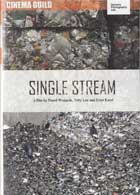
Single Stream 2014
Distributed by Cinema Guild, 115 West 30th Street, Suite 800, New York, NY 10001; 212-685-6242
Produced by Jesse Eidsness, Jonathan Hogg, Toby Lee, Pawel Wojtasik
Directed by Ernst Karel, Toby Lee, and Pawel Wojtasik
DVD , color, 23 min.
Middle School - General Adult
Recycling, Environmental Education, Cinema verite
Date Entered: 07/20/2015
Reviewed by Brian Boling, Temple University LibrariesSingle Stream is a fascinating documentary short that, using the modus operandi typical of Harvard’s Sensory Ethnography Laboratory, follows recyclables through a sorting facility in Charlestown, Massachusetts. Via an extreme form of cinéma vérité, the film guides the viewer along various stages of the rebirth cycle of consumer products. Like other Sensory Ethnography Lab projects, the film mixes hyper-realism with an eye-opening and uncanny look at the infrastructure supporting contemporary society. A conveyer belt drives the film’s opening narrative, reminding one of the Rube Goldberg homage The Way Things Go (1988), minus the whimsy.
For several minutes, one pictures an entirely automated process. Once the film reveals human assembly line sorters, our subsequent worry about the employees’ dehumanization brings a realization of our own environmental impact. As in Leviathan (2013), bird imagery provides a subtle nod to the artifice involved in filmmaking; here, instead of being Go-Pro’d upside-down, the birds are time-lapsed. Although birds appear immediately prior to the first shot of human intervention, the film grants humankind the last word in a seemingly staged closing scene in which the workers leave the plant in a single file line.
The film’s final moments, featuring a stacker driver carting away blocks of high-density polyethylene plastic, implies some level of human mastery over the consumption that characterizes our species. However, the Lab’s standard lack of interpretive voice-over leaves such conclusions as mere speculation. As such, the film would not only be of interest to film studies departments with a focus on experimental documentary form, but could also provide a useful think-piece for environmental studies students or other classes in the social sciences. The film’s short length and day-to-day interest may also prove useful in lessons aimed at younger students.